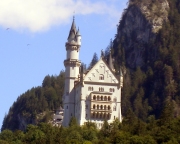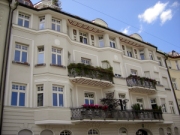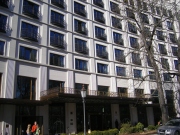Theatinerkirche at Odeonsplatz
The impressive Theatinerkirche (Theatine Church) at Odeonsplatz in the center is one of Munich's landmarks. With its bright yellow color, you can't miss it.

The full name is Theatine Church of St. Cajetan (Theatinerkirche St. Kajetan) and it's a Roman Catholic church, many say the most beautiful temple in Munich.
It was built in the 17th century in the Italian high-Baroque style and they say it's one of the most outstanding examples of Baroque architecture in all of Europe.
Church with Cloister
 Since 1954 Theatinerkirche is administered by Dominican monks who still live, work and pray here. Please be careful and polite when visiting the interior, because it's their home.
Since 1954 Theatinerkirche is administered by Dominican monks who still live, work and pray here. Please be careful and polite when visiting the interior, because it's their home.
There are frequent worships, some in English, and you're most welcome to assist a church service.
Even if you're not interested in the Catholic religion, you might still want to assist at least a little while, because the playing of the organ is spectacular.
Attend an Organ Concert
 If you've never heard one of these beautiful old organs in those gigantic churches, you've been missing out on something.
If you've never heard one of these beautiful old organs in those gigantic churches, you've been missing out on something.
Personally I think Theatine church is one of the most beautiful Lord's houses in Munich.
And if you think the bright yellow Rococo facade is spectacular, wait until you are inside. The Baroque interior is completely in white and stunningly overwhelming. I always get this feeling of being small and unimportant ...
The Royal Crypt

From the beginning it also served as a burial place for the royal Wittelsbach family. In the Fürstengruft (crypt) 47 members of the royal family have been buried in metall coffins.
A small chapel in the main church contains the tombs of King Maximilian II and his wife Queen Marie.
A little history
 For those of you interested in history and architecture, this house of prayers was inspired by Sant'Andrea della Valle in Rome and designed by an Italian architect (who else?), named Agostino Barelli.
For those of you interested in history and architecture, this house of prayers was inspired by Sant'Andrea della Valle in Rome and designed by an Italian architect (who else?), named Agostino Barelli.
The facade is in Rococo style, the interior in Italian Baroque and the facade was completed over a hundred years later by François de Cuvilliés who also built the Cuvilliés Theater, just across the street in the Residenz.
It took only 30 years to complete, which is a very short time (well, then it is a relatively small church), as for example the Cologne Cathedral took several hundreds of years and the Sagrada Familia in Barcelona still isn't finished today.
If you want to know more about the history of Theatine church, you can visit their website: Theatinerkirche









